课设实验报告 小组总和
课设实验报告 小组总和
北京电子科技学院
《信息安全工程技术应用》课程设计报告
基于密码算法库的国密算法支持研究与运用

小组成员姓名:
20201327 刘谨铭
20201310 何忠鑫
20201303 张奕博
指导教师: 娄嘉鹏
提交时间:2022年12月11日
一、设计方案及可行性分析
课程题目为基于密码算法库的国密算法支持研究,整体内容围绕国密算法展开,通过调用密码算法库自带的函数或命令行,验证密码算法库对国密算法的支持。
如今随着国密算法以sm2 sm3 sm4等密码算法成为国际标准,越来越多的密码算法库已经可以支持国密算法。如使用较为方便的openssl或其分支以国密命名的gmssl。因此想要找到支持国密算法的密码库并不是一件难事,团队的目标是尽可能在课设准备时间内找到更多支持国密算法的密码库或者工具包,并验证其可行性。
二、详细设计思路
首先将通用的密码算法库按支持的语言进行分配,小组总共三个人员,分别负责python ,c,java,还有go和js语言等其他语言,在查阅到资料的同时可以自行完成。
同时在自己部分实现上出现问题时 ,我们将进行统一的小组讨论,因为小组三人在python ,c,java三门语言上都有基础,讨论下解决问题更加快捷容易。
在查阅自己负责语言的资料时,发现了其他语言的密码算法库可以和其他组员分享,减少环境配置时间,提高对基于密码算法库的国密算法支持研究与运用的研究进度
三、设计特色
本次设计使用了OpenEuler操作系统,也是华为下的国产开源系统,在国产开源的操作系统下实现国密算法,也更加有利于国产密码算法的大力推广。
四、源代码及注释
通过gm-crypto密码算法库实现国密算法
SM2
const { SM2 } = require('gm-crypto')
const { publicKey, privateKey } = SM2.generateKeyPair()
const originalData = '20201327ljm'
const encryptedData = SM2.encrypt(originalData, publicKey, {
inputEncoding: 'utf8',
outputEncoding: 'base64'
})
console.log(encryptedData)
const decryptedData = SM2.decrypt(encryptedData, privateKey, {
inputEncoding: 'base64',
outputEncoding: 'utf8'
})
console.log(decryptedData)

SM3
const { SM3 } = require('gm-crypto')
console.log(SM3.digest('20201327'))
console.log(SM3.digest('ljm', 'base64'))
console.log(SM3.digest('415', 'hex', 'base64'))

SM4
const { SM4 } = require('gm-crypto')
const key = '0123456789abcdeffedcba9876543210' // Any string of 32 hexadecimal digits
const originalData = '20201327ljm'
/**
* Block cipher modes:
* - ECB: electronic codebook
* - CBC: cipher block chaining
*/
let encryptedData, decryptedData
// ECB
encryptedData = SM4.encrypt(originalData, key, {
inputEncoding: 'utf8',
outputEncoding: 'base64'
})
console.log(encryptedData)
decryptedData = SM4.decrypt(encryptedData, key, {
inputEncoding: 'base64',
outputEncoding: 'utf8'
})
console.log(decryptedData)
console.log('\n')
// CBC
const iv = '0123456789abcdeffedcba9876543210' // Initialization vector(any string of 32 hexadecimal digits)
encryptedData = SM4.encrypt(originalData, key, {
iv,
mode: SM4.constants.CBC,
inputEncoding: 'utf8',
outputEncoding: 'hex'
})
console.log(encryptedData)
decryptedData = SM4.decrypt(encryptedData, key, {
iv,
mode: SM4.constants.CBC,
inputEncoding: 'hex',
outputEncoding: 'utf8'
})
console.log(decryptedData)

通过sm-crypto密码算法库实现国密算法

sm2
const sm2 = require("miniprogram-sm-crypto").sm2;
let keypair = sm2.generateKeyPairHex();
publicKey = keypair.publicKey; // 公钥
privateKey = keypair.privateKey; // 私钥
const cipherMode = 1; // 1 - C1C3C2,0 - C1C2C3,默认为1
let encryptData = sm2.doEncrypt('20201327', publicKey, cipherMode); // 加密结果
console.log(encryptData)
let decryptData = sm2.doDecrypt(encryptData, privateKey, cipherMode); // 解密结果
console.log(decryptData)

sm3
const sm3 = require("miniprogram-sm-crypto").sm3;
let hashData = sm3("20201327"); // 杂凑
console.log(hashData)

sm4
const sm4 = require("miniprogram-sm-crypto").sm4;
const key = [0x01, 0x23, 0x45, 0x67, 0x89, 0xab, 0xcd, 0xef, 0xfe, 0xdc, 0xba, 0x98, 0x76, 0x54, 0x32, 0x10];
let encryptData = sm4.encrypt("20201327", key); // 加密
console.log(encryptData)
let decryptData = sm4.decrypt(encrytData, key); // 解密
console.log(decryptData)

python实现sm4
通过gmssl
##############################################################################
# #
# 国产SM4加密算法 #
# #
##############################################################################
import binascii
from gmssl import sm4
class SM4:
"""
国产加密 sm4加解密
"""
def __init__(self):
self.crypt_sm4 = sm4.CryptSM4() # 实例化
def str_to_hexStr(self, hex_str):
"""
字符串转hex
:param hex_str: 字符串
:return: hex
"""
hex_data = hex_str.encode('utf-8')
str_bin = binascii.unhexlify(hex_data)
return str_bin.decode('utf-8')
def encryptSM4(self, encrypt_key, value):
"""
国密sm4加密
:param encrypt_key: sm4加密key
:param value: 待加密的字符串
:return: sm4加密后的十六进制值
"""
crypt_sm4 = self.crypt_sm4
crypt_sm4.set_key(encrypt_key.encode(), sm4.SM4_ENCRYPT) # 设置密钥
date_str = str(value)
encrypt_value = crypt_sm4.crypt_ecb(date_str.encode()) # 开始加密。bytes类型
return encrypt_value.hex() # 返回十六进制值
def decryptSM4(self, decrypt_key, encrypt_value):
"""
国密sm4解密
:param decrypt_key:sm4加密key
:param encrypt_value: 待解密的十六进制值
:return: 原字符串
"""
crypt_sm4 = self.crypt_sm4
crypt_sm4.set_key(decrypt_key.encode(), sm4.SM4_DECRYPT) # 设置密钥
decrypt_value = crypt_sm4.crypt_ecb(bytes.fromhex(encrypt_value)) # 开始解密。十六进制类型
return decrypt_value.decode()
# return self.str_to_hexStr(decrypt_value.hex())
if __name__ == '__main__':
key = "f38fc9b32af486e65d6f93dbc41b9123"
strData = "90897h8789thvht"
SM4 = SM4()
print("原字符:", strData)
encData = SM4.encryptSM4(key, strData) # 加密后的数据,返回bytes类型
print("sm4加密结果:", encData)
decData = SM4.decryptSM4(key, encData)
print("sm4解密结果:", decData) # 解密后的数据

python通过gmssl实现sm2
import sys
from gmssl import sm2
from base64 import b64encode, b64decode
# sm2的公私钥
SM2_PRIVATE_KEY = '00B9AB0B828FF68872F21A837FC303668428DEA11DCD1B24429D0C99E24EED83D5'
SM2_PUBLIC_KEY = 'B9C9A6E04E9C91F7BA880429273747D7EF5DDEB0BB2FF6317EB00BEF331A83081A6994B8993F3F5D6EADDDB81872266C87C018FB4162F5AF347B483E24620207'
sm2_crypt = sm2.CryptSM2(public_key=SM2_PUBLIC_KEY, private_key=SM2_PRIVATE_KEY)
# 加密
def encrypt(info):
encode_info = sm2_crypt.encrypt(info.encode(encoding="utf-8"))
encode_info = b64encode(encode_info).decode() # 将二进制bytes通过base64编码
return encode_info
# 解密
def decrypt(info):
decode_info = b64decode(info.encode()) # 通过base64解码成二进制bytes
decode_info = sm2_crypt.decrypt(info).decode(encoding="utf-8")
return decode_info
if __name__ == "__main__":
action = sys.argv[1] # 取命令中的加解密动作
contact_info = sys.argv[2] # 取命令中需要加解密的内容
if action == "encrypt":
encrypted_contact_info = encrypt(contact_info)
print(encrypted_contact_info)
if action == "decrypt":
decrypted_contact_info = decrypt(contact_info)
print(decrypted_contact_info)

改进
from gmssl import sm2
# sm2的公私钥
SM2_PRIVATE_KEY = '00B9AB0B828FF68872F21A837FC303668428DEA11DCD1B24429D0C99E24EED83D5'
SM2_PUBLIC_KEY = 'B9C9A6E04E9C91F7BA880429273747D7EF5DDEB0BB2FF6317EB00BEF331A83081A6994B8993F3F5D6EADDDB81872266C87C018FB4162F5AF347B483E24620207'
sm2_crypt = sm2.CryptSM2(public_key=SM2_PUBLIC_KEY, private_key=SM2_PRIVATE_KEY)
# 加密
def encrypt(info):
encode_info = sm2_crypt.encrypt(info.encode(encoding="utf-8"))
return encode_info
# 解密
def decrypt(info):
decode_info = sm2_crypt.decrypt(info).decode(encoding="utf-8")
return decode_info
if __name__ == "__main__":
info = "123456"
encode_info = encrypt(info)
print(encode_info)
decode_info = decrypt(encode_info)
print(decode_info)

pysmx实现国密算法
sm2的签名验签
生成密钥
from pysmx.SM2 import generate_keypair
pk, sk = generate_keypair()
签名
from pysmx.SM2 import Sign
len_para = 64
sig = Sign("hello", sk, '123456', len_para)
验签
from pysmx.SM2 import Verify
len_para = 64
Verify(sig, "hello", pk, len_para) //True
Verify(sig, "Hello", pk, len_para) //False
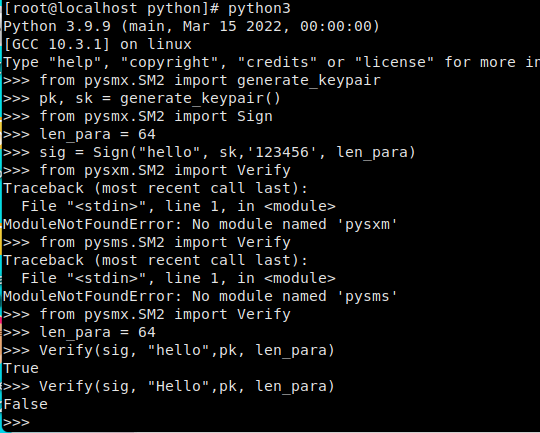
sm2加密解密
from pysmx.SM2 import Encrypt
e = b'20201327'
len_para = 64
C = Encrypt(e, pk, len_para, 0) # 此处的1代表e是否是16进制字符串
print(C)
m = Decrypt(C, sk, len_para)
print(m)

sm3
//方法一
from pysmx.SM3 import SM3
sm3 = SM3()
sm3.update('20201327ljm')
m=sm3.hexdigest()
print(m)
//方法二
from pysmx.SM3 import hash_msg
s = '20201327ljm'
n=hash_msg(s)
print(n)

sm4
//加密
from pysmx.SM4 import Sm4, ENCRYPT, DECRYPT
key_data = b'1111222233334444' # 至少16字节
sm4 = Sm4()
input_data = [1,2,3,4,5,6,7,8,9,10,11,12,13,14,15,16]
sm4.sm4_set_key(key_data, ENCRYPT)
msg = sm4.sm4_crypt_ecb(input_data)
print(msg)
//解密
sm4.sm4_set_key(key_data, DECRYPT)
m=sm4.sm4_crypt_ecb(msg)
print(m)

Python 通过gmx密码库实现sm2
https://gitee.com/cloud-in/national-secret-store/blob/master/刘谨铭第一周代码/python/sm2.py

Python 通过gmx密码库实现sm3
https://gitee.com/cloud-in/national-secret-store/blob/master/刘谨铭第一周代码/python/sm3.py

Python 通过gmx密码库实现sm4并与gmssl实现的sm4进行比较
https://gitee.com/cloud-in/national-secret-store/blob/master/刘谨铭第一周代码/python/sm4.py

openssl
检查 SM3 哈希校验和

检查椭圆曲线是否包含SM2

检查对称算法
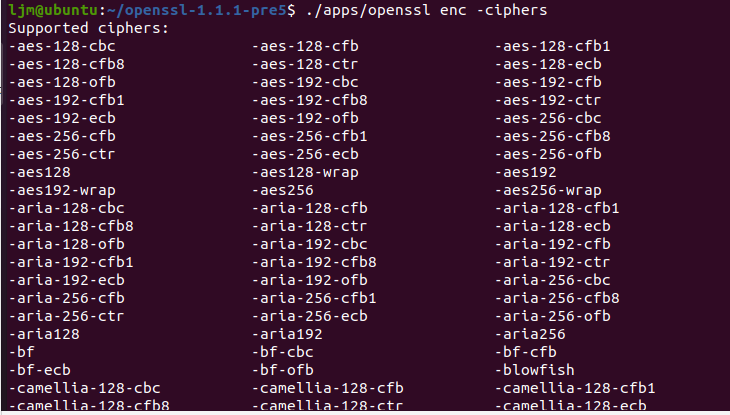
SM4-自测试数据
/** 文件名: https://github.com/liuqun/openssl-sm4-demo/blob/cmake/src/main.c */
#include <stddef.h>
#include <stdio.h>
#include <stdlib.h>
#include <string.h>
#include "openssl/err.h"
#include "openssl/evp.h"
/* Before OpenSSL 1.1.1-pre1, we did not have EVP_sm4_ecb() */
#if defined(OPENSSL_VERSION_NUMBER) \
&& OPENSSL_VERSION_NUMBER < 0x10101001L
static const EVP_CIPHER *(*EVP_sm4_ecb)()=EVP_aes_128_ecb;
#endif
typedef struct {
const unsigned char *in_data;
size_t in_data_len;
int in_data_is_already_padded;
const unsigned char *in_ivec;
const unsigned char *in_key;
size_t in_key_len;
} test_case_t;
void test_encrypt_with_cipher(const test_case_t *in, const EVP_CIPHER *cipher)
{
unsigned char *out_buf = NULL;
int out_len;
int out_padding_len;
EVP_CIPHER_CTX *ctx;
ctx = EVP_CIPHER_CTX_new();
EVP_EncryptInit_ex(ctx, cipher, NULL, in->in_key, in->in_ivec);
if (in->in_data_is_already_padded)
{
/* Check whether the input data is already padded.
And its length must be an integral multiple of the cipher's block size. */
const size_t bs = EVP_CIPHER_block_size(cipher);
if (in->in_data_len % bs != 0)
{
printf("ERROR-1: data length=%d which is not added yet; block size=%d\n", (int) in->in_data_len, (int) bs);
/* Warning: Remember to do some clean-ups */
EVP_CIPHER_CTX_free(ctx);
return;
}
/* Disable the implicit PKCS#7 padding defined in EVP_CIPHER */
EVP_CIPHER_CTX_set_padding(ctx, 0);
}
out_buf = (unsigned char *) malloc(((in->in_data_len>>4)+1) << 4);
out_len = 0;
EVP_EncryptUpdate(ctx, out_buf, &out_len, in->in_data, in->in_data_len);
if (1)
{
printf("Debug: out_len=%d\n", out_len);
}
out_padding_len = 0;
EVP_EncryptFinal_ex(ctx, out_buf+out_len, &out_padding_len);
if (1)
{
printf("Debug: out_padding_len=%d\n", out_padding_len);
}
EVP_CIPHER_CTX_free(ctx);
if (1)
{
int i;
int len;
len = out_len + out_padding_len;
for (i=0; i<len; i++)
{
printf("%02x ", out_buf[i]);
}
printf("\n");
}
if (out_buf)
{
free(out_buf);
out_buf = NULL;
}
}
void main()
{
int have_sm4 = (OPENSSL_VERSION_NUMBER >= 0x10101001L);
int have_aes = 1;
const unsigned char data[]=
{
0x01, 0x23, 0x45, 0x67, 0x89, 0xab, 0xcd, 0xef,
0xfe, 0xdc, 0xba, 0x98, 0x76, 0x54, 0x32, 0x10,
};
unsigned char ivec[EVP_MAX_IV_LENGTH]; ///< IV 向量
const unsigned char key1[16] = ///< key_data, 密钥内容, 至少16字节
{
0x01, 0x23, 0x45, 0x67, 0x89, 0xab, 0xcd, 0xef,
0xfe, 0xdc, 0xba, 0x98, 0x76, 0x54, 0x32, 0x10,
};
test_case_t tc;
tc.in_data = data;
tc.in_data_len = sizeof(data);
tc.in_data_is_already_padded = (tc.in_data_len % 16)==0; // Hard coded 16 as the cipher's block size
tc.in_key = key1;
tc.in_key_len = sizeof(key1);
memset(ivec, 0x00, EVP_MAX_IV_LENGTH);
tc.in_ivec = ivec;
#if defined(OPENSSL_NO_SM4)
have_sm4 = 0;
#endif
if (have_sm4)
{
printf("[1]\n");
printf("Debug: EVP_sm4_ecb() test\n");
test_encrypt_with_cipher(&tc, EVP_sm4_ecb());
}
#if defined(OPENSSL_NO_AES)
have_aes = 0;
#endif
if (have_aes)
{
printf("[2]\n");
printf("Debug: EVP_aes_128_ecb() test\n");
test_encrypt_with_cipher(&tc, EVP_aes_128_ecb());
}
}
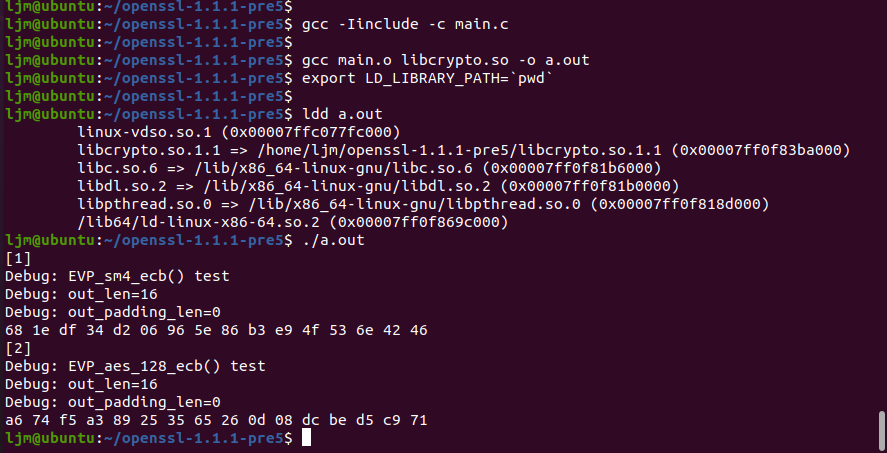
sm3直接加密文件

1.babassl
ZUC算法代码:
#include <stdio.h>
#include <string.h>
#include <openssl/crypto.h>
#include <openssl/evp.h>
int main(int argc, char *argv[])
{
EVP_MD_CTX *mctx = NULL;
EVP_PKEY_CTX *pctx = NULL;
EVP_PKEY *pkey = NULL;
unsigned char *got = NULL;
size_t got_len;
char *mac;
int rv;
const char key[] = {
0xc9, 0xe6, 0xce, 0xc4, 0x60, 0x7c, 0x72, 0xdb,
0x00, 0x0a, 0xef, 0xa8, 0x83, 0x85, 0xab, 0x0a
};
/*
* EIA3 的 iv 只有5个字节(只用到38bit),不是随机构造,构造方法如下:
* |----------32bit----------|-----5bit-----|---1bit---|
* | count | bearer | direction|
*/
const char *iv = "a94059da54";
const char msg[] = {
0x98, 0x3b, 0x41, 0xd4, 0x7d, 0x78, 0x0c, 0x9e,
0x1a, 0xd1, 0x1d, 0x7e, 0xb7, 0x03, 0x91, 0xb1,
0xde, 0x0b, 0x35, 0xda, 0x2d, 0xc6, 0x2f, 0x83,
0xe7, 0xb7, 0x8d, 0x63, 0x06, 0xca, 0x0e, 0xa0,
0x7e, 0x94, 0x1b, 0x7b, 0xe9, 0x13, 0x48, 0xf9,
0xfc, 0xb1, 0x70, 0xe2, 0x21, 0x7f, 0xec, 0xd9,
0x7f, 0x9f, 0x68, 0xad, 0xb1, 0x6e, 0x5d, 0x7d,
0x21, 0xe5, 0x69, 0xd2, 0x80, 0xed, 0x77, 0x5c,
0xeb, 0xde, 0x3f, 0x40, 0x93, 0xc5, 0x38, 0x81,
0x00
};
size_t msg_len = 73;
/*
* 将 EIA3 的 key 转换成 EVP_PKEY
*/
pkey = EVP_PKEY_new_raw_private_key(EVP_PKEY_EIA3, NULL, key, 16);
if (pkey == NULL)
goto end;
mctx = EVP_MD_CTX_new();
if (mctx == NULL)
goto end;
if (!EVP_DigestSignInit(mctx, &pctx, NULL, NULL, pkey))
goto end;
/*
* 设置 EIA3 的 iv,其中 iv 是十六进制的字符串形式
* 也可以设置 hexkey 来修改 key,同样是十六进制的字符吕形式
*/
rv = EVP_PKEY_CTX_ctrl_str(pctx, "iv", iv);
if (rv <= 0)
goto end;
if (!EVP_DigestSignUpdate(mctx, msg, msg_len))
goto end;
if (!EVP_DigestSignFinal(mctx, NULL, &got_len))
goto end;
got = OPENSSL_malloc(got_len);
if (got == NULL)
goto end;
if (!EVP_DigestSignFinal(mctx, got, &got_len))
goto end;
/*
* EIA3 的 mac 值为4个字节,这里打印出来
*/
mac = OPENSSL_buf2hexstr(got, got_len);
printf("MAC=%s\n", mac);
OPENSSL_free(mac);
end:
EVP_MD_CTX_free(mctx);
OPENSSL_free(got);
EVP_PKEY_free(pkey);
return 0;
}
ZUC测试截图

SM2代码:
//生成SM2私钥
openssl ecparam -genkey -name SM2 -out sm2.key
//生成证书签名请求 csr
openssl req -new -key sm2.key -out sm2.csr -sm3 -sigopt "sm2_id:1234567812345678"
//自签名测试证书
openssl x509 -req -in sm2.csr -signkey sm2.key -out sm2.crt -sm3 -sm2-id 1234567812345678 -sigopt "sm2_id:1234567812345678"
SM2测试截图

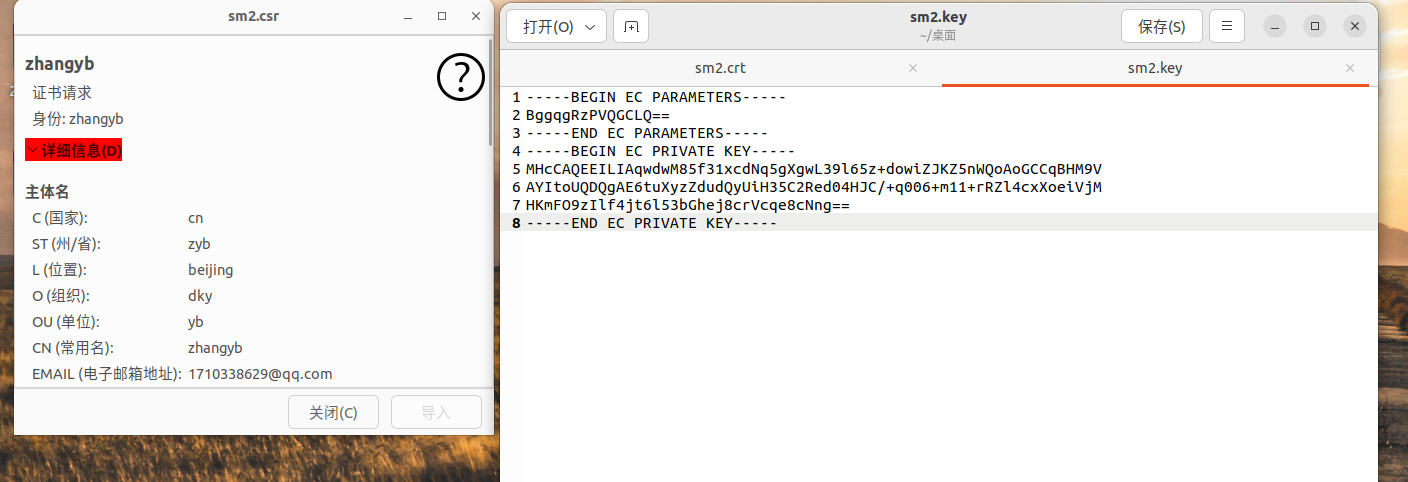
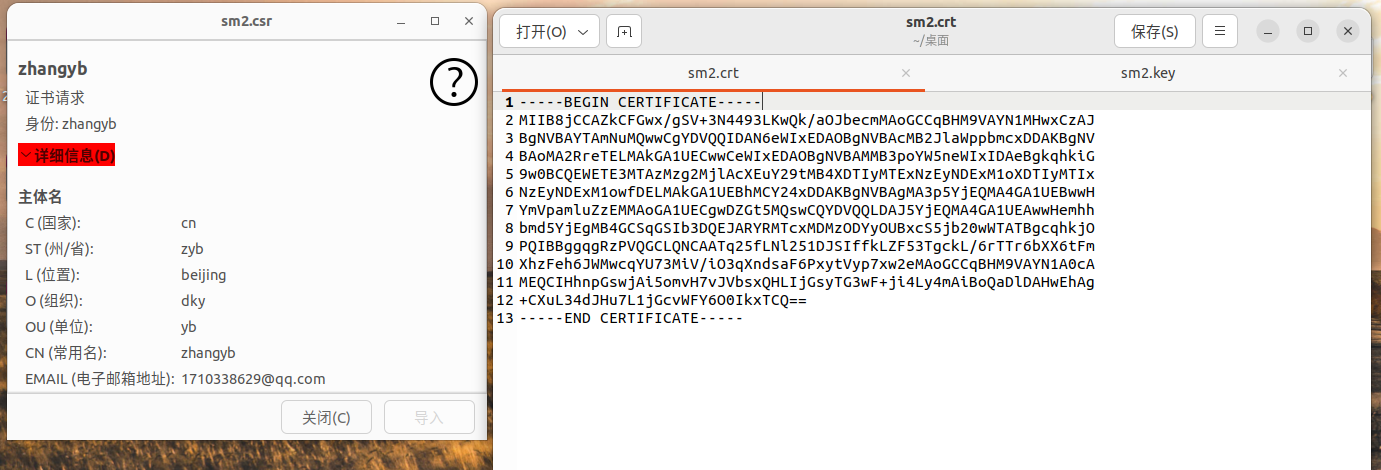
2.gmlib
SM3测试代码:
#include<gmlib/utils.h>
#include<gmlib/hash/sm3.h>
int main() {
SM3_CTX sm3_ctx;
uint8_t msg[] = {'a', 'b', 'c'}; // 原始消息
uint8_t digest[SM3_DIGEST_SIZE]; // 消息摘要
// 初始化 SM3
sm3_init(&sm3_ctx);
// 输入消息
sm3_update(msg, sizeof(msg), &sm3_ctx);
// 结束 SM3 并输出摘要 digest
sm3_final(digest, &sm3_ctx);
dump_data(digest, sizeof(digest));
/* SM3 摘要结果
66 c7 f0 f4 62 ee ed d9 d1 f2 d4 6b dc 10 e4 e2
41 67 c4 87 5c f2 f7 a2 29 7d a0 2b 8f 4b a8 e0
*/
return 0;
}

SM4测试代码:
#include <gmlib/cipher/mode.h>
#include <gmlib/cipher/sm4.h>
#include <gmlib/err.h>
#include <gmlib/utils.h>
static uint8_t sm4_key[SM4_KEYLEN] = {
0x01, 0x23, 0x45, 0x67, 0x89, 0xab, 0xcd, 0xef,
0xfe, 0xdc, 0xba, 0x98, 0x76, 0x54, 0x32, 0x10,
};
static uint8_t sm4_pt[SM4_BLOCK_SIZE] = {
0x00, 0x11, 0x22, 0x33, 0x44, 0x55, 0x66, 0x77,
0x88, 0x99, 0xaa, 0xbb, 0xcc, 0xdd, 0xee, 0xff,
};
static uint8_t out[SM4_BLOCK_SIZE * 2];
int main() {
SM4_CTX sm4key;
sm4_init(sm4_key, &sm4key);
sm4_encrypt(out, sm4_pt, &sm4key);
// 09 32 5c 48 53 83 2d cb 93 37 a5 98 4f 67 1b 9a
dump_data(out, SM4_BLOCK_SIZE);
ECB_CTX ctx;
uint8_t* outptr = out;
int outl;
ecb_init(sm4_key, &SM4Info, &sm4key, &ctx);
ecb_encrypt_update(outptr, &outl, sm4_pt, sizeof(sm4_pt), &ctx);
outptr += outl;
ecb_encrypt_final(outptr, &outl, &ctx);
outptr += outl;
// 09 32 5c 48 53 83 2d cb 93 37 a5 98 4f 67 1b 9a
// 00 2a 8a 4e fa 86 3c ca d0 24 ac 03 00 bb 40 d2
dump_data(out, (int)(outptr - out));
return 0;
}
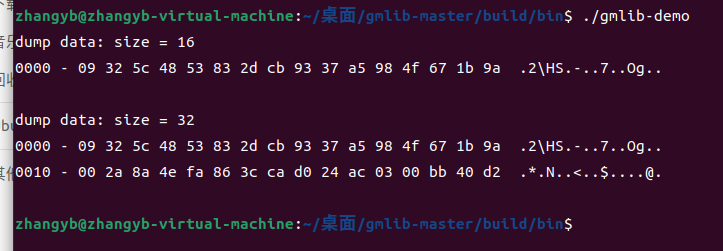
tjfoc-gm
代码:
package main
import (
"bytes"
"crypto/cipher"
"crypto/rand"
"fmt"
"log"
"github.com/Hyperledger-TWGC/tjfoc-gm/sm2"
"github.com/Hyperledger-TWGC/tjfoc-gm/sm3"
"github.com/Hyperledger-TWGC/tjfoc-gm/sm4"
)
func main() {
SM2()
SM3()
SM4()
}
func SM2() {
priv, err := sm2.GenerateKey(rand.Reader) // 生成密钥对
if err != nil {
log.Fatal(err)
}
msg := []byte("Tongji Fintech Research Institute")
pub := &priv.PublicKey
ciphertxt, err := sm2.Encrypt(pub, msg, rand.Reader)
if err != nil {
log.Fatal(err)
}
fmt.Println("SM2加密密文是:", string(msg))
fmt.Printf("SM2加密结果是:%x\n", ciphertxt)
plaintxt, err := priv.Decrypt(nil, ciphertxt, nil)
if err != nil {
log.Fatal(err)
}
if !bytes.Equal(msg, plaintxt) {
log.Fatal("原文不匹配")
}
sign, err := priv.Sign(rand.Reader, msg, nil)
if err != nil {
log.Fatal(err)
}
isok := priv.PublicKey.Verify(msg, sign)
fmt.Printf("SM2 Verified: %v\n", isok)
}
func SM3() {
data := "test"
h := sm3.New()
h.Write([]byte(data))
sum := h.Sum(nil)
fmt.Printf("SM3 digest value is: %x\n", sum)
}
func SM4() {
// 128比特密钥
key := []byte("1234567890abcdef")
// 128比特iv
iv := make([]byte, sm4.BlockSize)
data := []byte("Tongji Fintech Research Institute")
fmt.Println("SM4加密密文是:", string(data))
ciphertxt, err := sm4Encrypt(key, iv, data)
if err != nil {
log.Fatal(err)
}
fmt.Printf("SM4加密结果: %x\n", ciphertxt)
res, err := sm4Decrypt(key, iv, ciphertxt)
if err != nil {
log.Fatal(err)
}
fmt.Printf("SM4解密结果: %x\n", res)
fmt.Println("SM4解密密文是:", string(res))
}
func sm4Encrypt(key, iv, plainText []byte) ([]byte, error) {
block, err := sm4.NewCipher(key)
if err != nil {
return nil, err
}
blockSize := block.BlockSize()
origData := pkcs5Padding(plainText, blockSize)
blockMode := cipher.NewCBCEncrypter(block, iv)
cryted := make([]byte, len(origData))
blockMode.CryptBlocks(cryted, origData)
return cryted, nil
}
func sm4Decrypt(key, iv, cipherText []byte) ([]byte, error) {
block, err := sm4.NewCipher(key)
if err != nil {
return nil, err
}
blockMode := cipher.NewCBCDecrypter(block, iv)
origData := make([]byte, len(cipherText))
blockMode.CryptBlocks(origData, cipherText)
origData = pkcs5UnPadding(origData)
return origData, nil
}
// pkcs5填充
func pkcs5Padding(src []byte, blockSize int) []byte {
padding := blockSize - len(src)%blockSize
padtext := bytes.Repeat([]byte{byte(padding)}, padding)
return append(src, padtext...)
}
func pkcs5UnPadding(src []byte) []byte {
length := len(src)
if length == 0 {
return nil
}
unpadding := int(src[length-1])
return src[:(length - unpadding)]
}
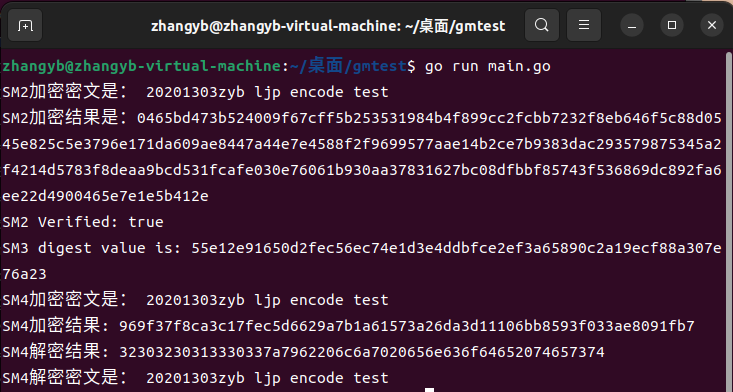
crypto++
代码:
#include "pch.h"
#include <string>
#include <cstring>
#include <vector>
#include <iostream>
#include <fstream>
#include <iomanip>
#include <algorithm>
#include "cryptopp/aes.h"
#include "cryptopp/filters.h"
#include "cryptopp/modes.h"
using namespace std;
using namespace CryptoPP;
byte key[CryptoPP::AES::DEFAULT_KEYLENGTH], iv[CryptoPP::AES::BLOCKSIZE];
void initKV() {
memset(key, 0x00, CryptoPP::AES::DEFAULT_KEYLENGTH);
memset(iv, 0x00, CryptoPP::AES::BLOCKSIZE);
}
string encrypt(string plainText) {
string cipherText;
CryptoPP::AES::Encryption aesEncryption(key, CryptoPP::AES::DEFAULT_KEYLENGTH);
CryptoPP::CBC_Mode_ExternalCipher::Encryption cbcEncryption(aesEncryption, iv);
CryptoPP::StreamTransformationFilter stfEncryptor(cbcEncryption, new CryptoPP::StringSink(cipherText));
stfEncryptor.Put(reinterpret_cast<const unsigned char*>(plainText.c_str()), plainText.length() + 1);
stfEncryptor.MessageEnd();
string cipherTextHex;
for (int i = 0; i < cipherText.size(); i++)
{
char ch[3] = { 0 };
sprintf_s(ch, "%02x", static_cast<byte>(cipherText[i]));
cipherTextHex += ch;
}
return cipherTextHex;
}
int main() {
string text = "20201303zyb";
cout << "text : " << text << endl;
initKV();
string cipherHex = encrypt(text);
cout << "cipher : " << cipherHex << endl;
}

Miracl
代码:
#include <stdio.h>
#include <string.h>
#include <time.h>
#include "sm9/sm9_algorithm.h"
#include "sm9/print_out.h"
#define TEST 100
int main(int argc, char **argv)
{
printf("20201303begin test \n");
//===========签名用到的参数==========
unsigned char cks[32] = "\x86\xDC\xD6\x4F\xEB\x81\xA7\x19\x63\x59\x59\xF1\xA5\xC2\xF9\x88\xBD\x39\x43\x1B\x08\xA8\x63\xF0\x42\x8D\x21\xDF\xFA\xF2\xBF\x89";
unsigned char id[5] = {"\x41\x6C\x69\x63\x65"};
unsigned char rand[32] = {"\x1A\x23\x29\x77\xBA\x9F\xA2\xD1\xC5\x58\xF2\xD4\x67\xFE\x7B\xE7\x04\x05\x41\x26\x73\xF8\xBE\x64\x9B\xBD\xD4\xA0\x95\xBE\x1B\x4B"};
unsigned char msg[20] = {"\x43\x68\x69\x6E\x65\x73\x65\x20\x49\x42\x53\x20\x73\x74\x61\x6E\x64\x61\x72\x64"};
//========加密用到的参数===================
unsigned char cmsg[20] = {"\x43\x68\x69\x6E\x65\x73\x65\x20\x49\x42\x45\x20\x73\x74\x61\x6E\x64\x61\x72\x64"};
unsigned char eks[32] = {"\x00\x01\xED\xEE\x37\x78\xF4\x41\xF8\xDE\xA3\xD9\xFA\x0A\xCC\x4E\x07\xEE\x36\xC9\x3F\x9A\x08\x61\x8A\xF4\xAD\x85\xCE\xDE\x1C\x22"};
unsigned char eid[3] = {"\x42\x6F\x62"};
unsigned char er[32] = {"\x00\x00\xAA\xC0\x54\x17\x79\xC8\xFC\x45\xE3\xE2\xCB\x25\xC1\x2B\x5D\x25\x76\xB2\x12\x9A\xE8\xBB\x5E\xE2\xCB\xE5\xEC\x9E\x78\x5C"};
unsigned char plain[32];
unsigned int plainlen;
//==============密钥交换用到的参数================
unsigned char kks[32] = {"\x00\x02\xE6\x5B\x07\x62\xD0\x42\xF5\x1F\x0D\x23\x54\x2B\x13\xED\x8C\xFA\x2E\x9A\x0E\x72\x06\x36\x1E\x01\x3A\x28\x39\x05\xE3\x1F"};
unsigned char alice[5] = {"\x41\x6C\x69\x63\x65"};
unsigned char bob[3] = {"\x42\x6F\x62"};
unsigned char ra[32] = {"\x00\x00\x58\x79\xDD\x1D\x51\xE1\x75\x94\x6F\x23\xB1\xB4\x1E\x93\xBA\x31\xC5\x84\xAE\x59\xA4\x26\xEC\x10\x46\xA4\xD0\x3B\x06\xC8"};
unsigned char rb[32] = {"\x00\x01\x8B\x98\xC4\x4B\xEF\x9F\x85\x37\xFB\x7D\x07\x1B\x2C\x92\x8B\x3B\xC6\x5B\xD3\xD6\x9E\x1E\xEE\x21\x35\x64\x90\x56\x34\xFE"};
time_t start,end;
int res;
unsigned char *gg;
unsigned char AS1[32];
unsigned char AS2[32];
unsigned char ASK[16];
unsigned char BS1[32];
unsigned char BS2[32];
unsigned char BSK[16];
//============独立验证时用到的参数==========
unsigned char x1[32] = {"\x0f\xbd\x02\x40\x35\xb4\xca\x2f\x94\x14\x4f\xdf\x33\x3b\xf8\xe1\x81\x74\x7c\x8d\xd8\x5d\xe4\x12\xad\xc7\x18\x18\x98\x72\x43\x27"};
unsigned char x2[32] = {"\x13\x2d\x39\x44\x38\x7b\x63\x1e\xe4\xb0\x55\x89\x9f\x6c\xfe\x42\x8f\xb9\xfc\x9f\xa2\x75\x68\x9f\xeb\x36\xbe\x2b\x60\x21\xea\xbe"};
unsigned char y1[32] = {"\x07\x81\x20\x17\xdb\x06\x91\xd3\x43\x11\x36\x83\x21\x19\xe0\xe1\x94\x4e\x85\x5a\xed\xfc\xa7\x10\xed\xd1\x46\x6e\x69\x01\x8e\xa1"};
unsigned char y2[32] = {"\x89\xf9\xf0\x0f\x5e\x05\x10\x6c\xb3\x4f\x60\x0f\xd9\x48\x92\x4b\x87\x24\x7b\xde\x11\xdf\x34\x01\x3d\xb6\xb9\x54\xbb\xf1\x9a\x55"};
unsigned char h[32] = {"\xa1\xc3\xa6\xce\x30\x90\xea\x0d\xbd\x07\xe2\x1b\xcb\xdb\x43\x40\x4b\x80\x98\xf1\x90\x4d\xd6\xe7\x28\x3c\x7d\xfc\xdb\x23\x65\x91"};
unsigned char xs[32] = {"\x2f\x5f\xe6\x33\xb6\x04\x16\x76\xfe\x77\x0d\x3f\xd3\x09\x6e\x0b\x64\xb0\x01\x0e\x1d\xa5\x50\x96\x5c\xd1\x94\xad\x53\x51\xa4\x98"};
unsigned char ys[32] = {"\x51\x2b\x48\xf2\xae\xde\x4b\x10\xef\x25\xca\x58\x46\x49\x93\x8b\xfc\xd6\x3e\xe8\xb4\x8f\xbb\x86\xeb\x82\xa8\x22\x42\x97\x63\x14"};
//如下可以使用SM9 第五部分 指定的曲线类型和主密钥初始化系统
//也可以使用自定义曲线
//
SM9_Init(0,0,32,NULL,NULL, NULL, NULL, NULL, NULL, NULL, NULL, NULL, NULL, NULL );
// ========================================================
SM9_MSK msk = SM9_MSK_New(32, cks); // 申明一个签名主密钥
SM9_MSPK mspk = SM9_MSPK_New(32); //申明一个主签名公钥
SM9_GenMSignPubKey(&msk, &mspk); // 生成签名主公钥
gg = SM9_Set_Sign(mspk.x1, mspk.x2, mspk.y1, mspk.y2, NULL); // 启动签名lib
if (gg == NULL){
printf("init sign lib error\n");
return 1;
}
SM9_PK pk = SM9_PK_New(5, id); // 申明一个签名公钥
SM9_SSK sk = SM9_SSK_New(32); // 申明一个签名私钥
SM9_GenSignSecKey(&sk, &pk, &msk); // 由公钥(id)生成签名私钥
SM9_Sign sign = SM9_Sign_New(32); // 申明一个签名体
//===============signature test===============
//使用私钥sk和随机数ran,对消息mes签名
time(&start);
for(int i=0;i<TEST;i++){
SM9_Signature(msg, 20, rand, &sk, &sign);
}
time(&end);
printf("sign %d time is %ld sec\n",TEST, end-start);
time(&start);
for(int i=0;i<TEST;i++){// 验证函数
res = SM9_Verify(msg, 20, &sign, &pk, NULL);
if (res) printf("verify error at %d = %d\n", i,res);
}
time(&end);
printf("verify %d time is %ld sec\n",TEST, end-start);
//===============independent verify test===============
SM9_Free(); //注销SM9
//重新启动SM9
SM9_Init(0,0,32,NULL,NULL, NULL, NULL, NULL, NULL, NULL, NULL, NULL, NULL, NULL );
SM9_MSPK inmspk = SM9_MSPK_New(32);
SM9_Sign insign = SM9_Sign_New(32);
SM9_PK inpk = SM9_PK_New(5, id);
inmspk.secLevel =32;
inmspk.x1 = x1;
inmspk.x2 = x2;
inmspk.y1 = y1;
inmspk.y2 = y2;
gg = SM9_Set_Sign(inmspk.x1, inmspk.x2, inmspk.y1, inmspk.y2, NULL); // 启动签名lib
if (gg == NULL){
printf("init sign lib error\n");
return 1;
}
insign.h = h;
insign.xs = xs;
insign.ys = ys;
int inres;
inres = SM9_Verify(msg, 20, &insign, &inpk, NULL);
if (inres) {
printf("independent verify error = %d\n",inres);
}else{
printf("independent verify success! \n");
}
//===============encryption test===============
SM9_MSK esk = SM9_MSK_New(32, eks); // 申明一个加密主密钥
SM9_MCPK mcpk = SM9_MCPK_New(32); //申明一个主加密公钥
SM9_GenMEncryptPubKey(&esk, &mcpk); // 生成加密主公钥
gg = SM9_Set_Encrypt(mcpk.x, mcpk.y,NULL); // 启动加密lib
if (gg == NULL){
printf("init encryption lib error\n");
return 1;
}
SM9_PK epk = SM9_PK_New(3, eid); //申明一个加密公钥
SM9_CSK csk = SM9_CSK_New(32); //申明一个加密私钥
SM9_GenEncryptSecKey(&csk, &epk, &esk); // 由公钥(id)生成加密私钥
SM9_Cipher cipher = SM9_Cipher_New(32);
time(&start);
for(int i=0;i<TEST;i++){
SM9_Encrypt(cmsg, 20, KDF_SM4, er, &epk, &cipher);
}
time(&end);
printf("Encrypt %d time is %ld sec\n",TEST, end-start);
time(&start);
for(int i=0;i<TEST;i++){
res = SM9_Decrypt(&epk, KDF_SM4, &csk, &cipher, plain, &plainlen);
if (res) printf("decrypt error code is %d \n", res);
}
time(&end);
printf("Decrypt %d time is %ld sec\n",TEST, end-start);
//===============keyexchange test===============
SM9_MSK ksk = SM9_MSK_New(32, kks);
SM9_MKPK mkpk = SM9_MKPK_New(32); //申明一个主协商公钥
SM9_GenMKeyExchangePubKey(&ksk, &mkpk); // 生成协商主公钥
gg = SM9_Set_KeyExchange(mkpk.x, mkpk.y,NULL); // 启动协商lib
if (gg == NULL){
printf("init keyexchange lib error\n");
return 1;
}
SM9_PK apk = SM9_PK_New(5, alice);
SM9_KSK ask = SM9_KSK_New(32);
SM9_GenKeyExchangeSecKey(&ask, &apk, &ksk);
SM9_PK bpk = SM9_PK_New(3, bob);
SM9_KSK bsk = SM9_KSK_New(32);
SM9_GenKeyExchangeSecKey(&bsk, &bpk, &ksk);
SM9_Send ase = SM9_Send_New(32);
SM9_Send bse = SM9_Send_New(32);
SM9_SendStep(ra, &bpk, &ase);
SM9_SendStep(rb, &apk, &bse);
time(&start);
for(int i=0;i<TEST;i++){
SM9_ReceiveStep(ra, &ase, &bse, &apk, &bpk, &ask, 16, AS1, AS2, ASK, AKE_SENDER);
SM9_ReceiveStep(rb, &bse, &ase, &bpk, &apk, &bsk, 16, BS1, BS2, BSK, AKE_RECEIVER);
if(SM9_CheckStep(AS1, BS2)) printf("error at step 1\n");
if(SM9_CheckStep(AS2, BS1)) printf("error at step 2\n");
}
time(&end);
printf("key exchange %d time is %ld sec\n", TEST*2,end-start);
printf("end test \n ================== \n");
return 0;
}
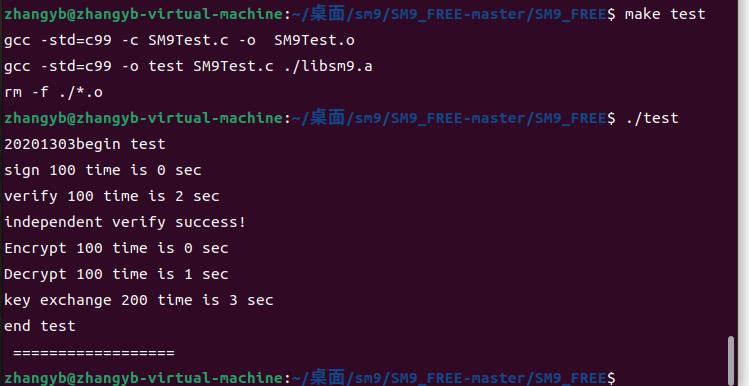
GMSSL
sm3命令行:
echo '20201303zyb' | gmssl sm3

OPENSSL
SM4代码
#include <stddef.h>
#include <stdio.h>
#include <stdlib.h>
#include <string.h>
#include "openssl/err.h"
#include "openssl/evp.h"
/* Before OpenSSL 1.1.1-pre1, we did not have EVP_sm4_ecb() */
#if defined(OPENSSL_VERSION_NUMBER) \
&& OPENSSL_VERSION_NUMBER < 0x10101001L
static const EVP_CIPHER *(*EVP_sm4_ecb)()=EVP_aes_128_ecb;
#endif
typedef struct {
const unsigned char *in_data;
size_t in_data_len;
int in_data_is_already_padded;
const unsigned char *in_ivec;
const unsigned char *in_key;
size_t in_key_len;
} test_case_t;
void test_encrypt_with_cipher(const test_case_t *in, const EVP_CIPHER *cipher)
{
unsigned char *out_buf = NULL;
int out_len;
int out_padding_len;
EVP_CIPHER_CTX *ctx;
ctx = EVP_CIPHER_CTX_new();
EVP_EncryptInit_ex(ctx, cipher, NULL, in->in_key, in->in_ivec);
if (in->in_data_is_already_padded)
{
/* Check whether the input data is already padded.
And its length must be an integral multiple of the cipher's block size. */
const size_t bs = EVP_CIPHER_block_size(cipher);
if (in->in_data_len % bs != 0)
{
printf("ERROR-1: data length=%d which is not added yet; block size=%d\n", (int) in->in_data_len, (int) bs);
/* Warning: Remember to do some clean-ups */
EVP_CIPHER_CTX_free(ctx);
return;
}
/* Disable the implicit PKCS#7 padding defined in EVP_CIPHER */
EVP_CIPHER_CTX_set_padding(ctx, 0);
}
out_buf = (unsigned char *) malloc(((in->in_data_len>>4)+1) << 4);
out_len = 0;
EVP_EncryptUpdate(ctx, out_buf, &out_len, in->in_data, in->in_data_len);
if (1)
{
printf("Debug: out_len=%d\n", out_len);
}
out_padding_len = 0;
EVP_EncryptFinal_ex(ctx, out_buf+out_len, &out_padding_len);
if (1)
{
printf("Debug: out_padding_len=%d\n", out_padding_len);
}
EVP_CIPHER_CTX_free(ctx);
if (1)
{
int i;
int len;
len = out_len + out_padding_len;
for (i=0; i<len; i++)
{
printf("%02x ", out_buf[i]);
}
printf("\n");
}
if (out_buf)
{
free(out_buf);
out_buf = NULL;
}
}
void main()
{
int have_sm4 = (OPENSSL_VERSION_NUMBER >= 0x10101001L);
int have_aes = 1;
const unsigned char data[]=
{
0x01, 0x23, 0x45, 0x67, 0x89, 0xab, 0xcd, 0xef,
0xfe, 0xdc, 0xba, 0x98, 0x76, 0x54, 0x32, 0x10,
};
unsigned char ivec[EVP_MAX_IV_LENGTH]; ///< IV 向量
const unsigned char key1[16] = ///< key_data, 密钥内容, 至少16字节
{
0x01, 0x23, 0x45, 0x67, 0x89, 0xab, 0xcd, 0xef,
0xfe, 0xdc, 0xba, 0x98, 0x76, 0x54, 0x32, 0x10,
};
test_case_t tc;
tc.in_data = data;
tc.in_data_len = sizeof(data);
tc.in_data_is_already_padded = (tc.in_data_len % 16)==0; // Hard coded 16 as the cipher's block size
tc.in_key = key1;
tc.in_key_len = sizeof(key1);
memset(ivec, 0x00, EVP_MAX_IV_LENGTH);
tc.in_ivec = ivec;
#if defined(OPENSSL_NO_SM4)
have_sm4 = 0;
#endif
if (have_sm4)
{
printf("[1]\n");
printf("Debug: EVP_sm4_ecb() test\n");
test_encrypt_with_cipher(&tc, EVP_sm4_ecb());
}
#if defined(OPENSSL_NO_AES)
have_aes = 0;
#endif
if (have_aes)
{
printf("[2]\n");
printf("Debug: EVP_aes_128_ecb() test\n");
test_encrypt_with_cipher(&tc, EVP_aes_128_ecb());
}
}

SM3代码
#include <stdio.h>
#include <string.h>
#include <openssl/evp.h>
#include <openssl/err.h>
void tDigest(){
unsigned char md_value[EVP_MAX_MD_SIZE];
unsigned int md_len;
EVP_MD_CTX *mdctx;
mdctx = EVP_MD_CTX_new();
char msg1[] = "20201303";
char msg2[] = "ZHANGyibo";
EVP_MD_CTX_init(mdctx);
EVP_DigestInit_ex(mdctx, EVP_sm3(), NULL);
EVP_DigestUpdate(mdctx, msg1, strlen(msg1));
EVP_DigestUpdate(mdctx, msg2, strlen(msg2));
EVP_DigestFinal_ex(mdctx, md_value, &md_len);
EVP_MD_CTX_destroy(mdctx);
printf("Debug:Message1%s and Message2%s digest to:\n",msg1, msg2);
for(int i = 0; i<md_len; i++){
printf("0x%02x ", md_value[i]);
}
printf("\n");
}
int main(){
OpenSSL_add_all_algorithms();
tDigest();
return 0;
}

五、个人报告
1.小组贡献排序及依据(每个人的工作量):
1)、刘谨铭
调试node.js 语言中gm-crypto密码算法库实现国密算法
调试node.js 语言中sm-crypto密码算法库实现国密算法
调试python语言中gmssl算法库实现国密算法
调试python语言中pysmx算法库实现国密算法
共同调试c语言中openssl、gmssl、crypt++算法库
2)、何忠鑫
调试Java语言中bouncycastle算法库实现国密算法
调试Java语言中crypto-gmsm算法库实现国密算法
调试Java语言中Hutool算法库实现国密算法
共同调试c语言中openssl,gmssl,crypt++,gmlib和Miracl算法库
3)、张奕博
调试C语言中babassl秘密算法库实现国密算法
调试C语言中gmlib密码算法库实现国密算法
调试go语言中的tjfoc-gm密码库实现国密算法
调试C语言中crypto++密码库实现国密算法
调试C语言中Miracl密码库实现国密算法
共同调试c语言中openssl、gmssl算法库
2.遇到的问题及解决方法
在调试crypt++的时候按照crypt++中install文件进行make配置其环境变量时失败,在尝试网上多种方法任然失败
解决方法:通过VS在Windows环境下成功运行。
很多代码调试出现问题,代码提示缺少头文件等报错
其实,后面基本每个算法库都会有头文件报错等问题,但是每个算法库的对应解决方法不太一样,这里列举一下
①BABASSL头文件丢失的问题,我找到对应算法库缺失的代码加入静态链接就好了
②gmlib头文件丢失问题,编译时出现问题,这时候修改cmakelist.txt文件,发现make编译出现的问题,这时候修改文件将最后编译的内容改成自己要编译的文件即可。
③tjfoc-gm头文件丢失,这时候用go get从github上把库copy下来就行了
④crypto++头文件丢失,这时候我们采用vs软件重新编译,按着网络上找的攻略就好
⑤mircal头文件丢失,这时候我们修改makefile文件,将其补充完整就行
有些函数跑不了
基本上出现的问题都是因为密码库版本和网络上查的攻略版本不同,总之要注意一下版本兼容性,有些密码库比如gmssl在2.4之后支持SM2,SM3,SM4等内容,但是我下载的是GMSSL3.1.0出现了和攻略不兼容的问题,修改版本成gmssl2.4.0版本后就可以运行。
3.心得体会
刘谨铭同学说:本次设计我主要负责完成python语言和js语言两个部分的密码算法库,首先在资料查找上,以前在完成作业遇到困难的时候一般就是通过百度、csdn、博客园进行查阅学习,但是在进行这次设计的过程中,openEuler操作系统和国密算法双重条件下,导致按照之前的方法查阅到的资料有限而且准确度不高,通过这次课设,我会开始在git和通过官网来查阅资料,特别是官网,不仅里面的代码的准确性额能得到保障,而且能够较快的发现是否能够支持国密算法;其次就是密码算法库是否能支持国密算法,我在这次课设中是采用先找库,然后在研究这个库是否支持国密算法,因此在途中遇到了很多的困难,也会在费了很多心思,查阅很多资料之后得到这个库应该是不能实现国密算法的失望结果。但是总而言之,这次课设是一次十分宝贵的经历,很大程度的提高了我的动手能力,增强了团队意识,遇到自己难以解决的问题,到团队里就可能迎刃而解。
张奕博同学说:本次课设,我负责完成C语言和GO语言的部分,也是尝试了很多的库,但是成功的和失败的基本上是一半一半,其中遇到了非常多的问题,但是我并没有遇到困难而放弃,遇到问题就解决,虽然可以经常一个代码很多的报错,但是其实就是一个头文件的问题,解决了之后许多报错就同步消失了。总之,这次课设难度很高,但是经过很多的考验,我们组也顺利完成任务,基本完成各项代码的调试。
4.参考资料(图书、网址…)
https://zhuanlan.zhihu.com/p/92916246
https://blog.csdn.net/qq_41521682/article/details/122800226
https://pypi.org/project/snowland-smx/
https://cryptopp.com/
https://gitcode.net/mirrors/byte-fe/gm-crypto?utm_source=csdn_github_accelerator
https://gitee.com/zhaochuninhefei/gmgo
https://www.cnblogs.com/lsdb/p/10912518.html
https://gitee.com/basddsa/hggm#https://gitee.com/link?target=https%3A%2F%2Fblog.csdn.net%2Fqq_43339242%2Farticle%2Fdetails%2F123709822
https://gitcode.net/mirrors/babassl/babassl
https://github.com/stan1y/gmlib
https://golang.google.cn/dl/
https://blog.csdn.net/qq_32261191/article/details/78855651
https://blog.csdn.net/Yonggie/article/details/100592532
https://cryptopp.com/
https://github.com/songgeng87/SM9_FREE
https://github.com/guanzhi/GmSSL
https://www.cnblogs.com/hzxjkl/p/16828260.html
https://www.cnblogs.com/PiaYie/p/16746335.html



【推荐】国内首个AI IDE,深度理解中文开发场景,立即下载体验Trae
【推荐】编程新体验,更懂你的AI,立即体验豆包MarsCode编程助手
【推荐】抖音旗下AI助手豆包,你的智能百科全书,全免费不限次数
【推荐】轻量又高性能的 SSH 工具 IShell:AI 加持,快人一步
· 震惊!C++程序真的从main开始吗?99%的程序员都答错了
· 【硬核科普】Trae如何「偷看」你的代码?零基础破解AI编程运行原理
· 单元测试从入门到精通
· 上周热点回顾(3.3-3.9)
· winform 绘制太阳,地球,月球 运作规律